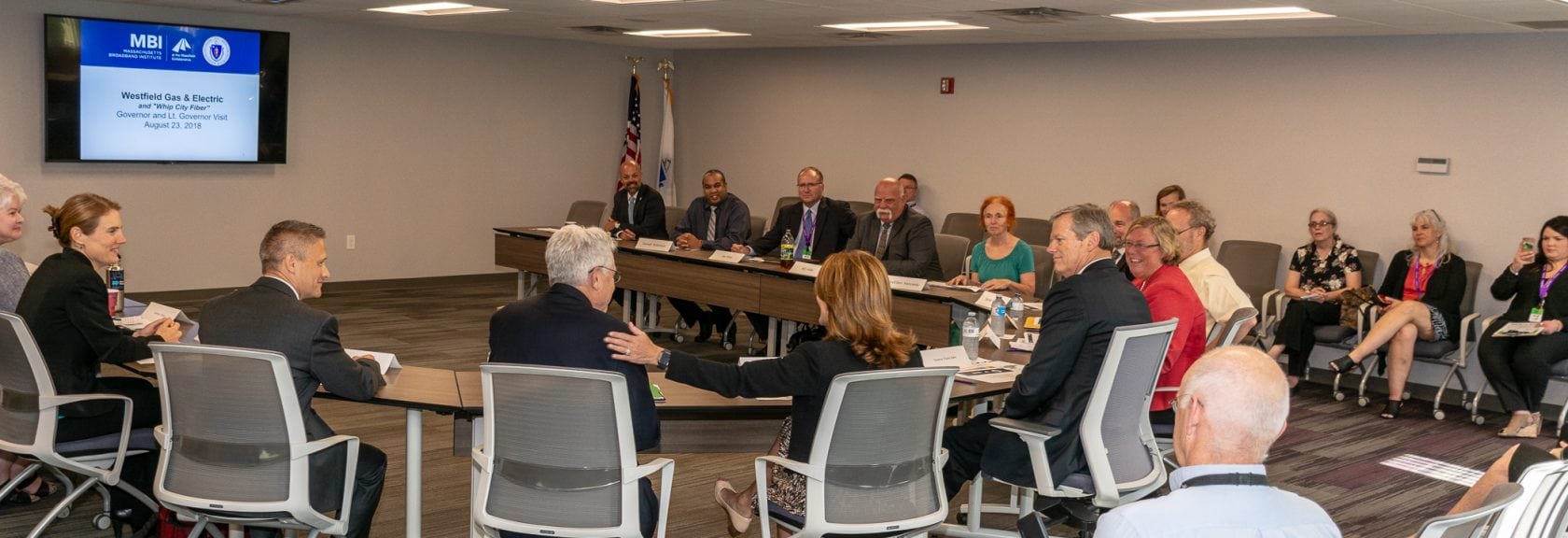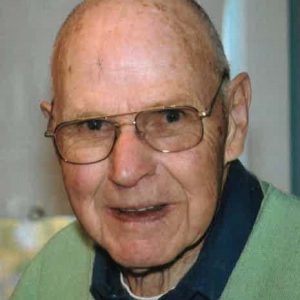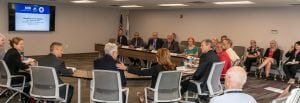
The Governor and Lt. Governor attended a roundtable at Westfield G&E on Whip City Fiber Thursday. (Photo by Lynn F. Boscher)
WESTFIELD – Governor Charlie Baker, Lt. Governor Karyn Polito, and representatives from the Executive Office for Housing and Economic Development visited Westfield Gas & Electric on Thursday to thank them for their efforts in helping to bring broadband to twenty plus hilltown communities. Also present were State Senator Adam G. Hinds, who represents many of the towns that WG&E is helping, and Westfield Mayor Brian P. Sullivan.
At the start of the meeting, Gov. Baker asked WG&E General Manager Dan Howard to tell him about the utility and the Whip City Fiber initiative. Howard said the Municipal Light Plant (MLP) has 18,000 electric customers, 10,000 natural gas customers, and serves the 47 square miles of Westfield.
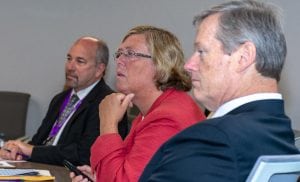
WG&E General Manager Dan Howard, EOHED Deputy Secretary Carolyn Kirk and Governor Charlie Baker pay close attention. (Photo by Lynn F. Boscher)
He said strategic planning started five years ago with the Mayor’s office for the fiber network. “The community wanted a choice,” Howard said, adding, “Three years ago we started this venture of Whip City Fiber, which has now expanded to the hilltowns.”
Howard said WG&E is providing assistance with engineering, procurement and customer service for the towns, who are also MLPs, and who reached out to WG&E for advice and help. Howard also said that the towns will own their own networks, and put up their own money.
“These towns are too small to take it off the ground. They approached us, and are following a model we started. They asked us to manage it. It’s an extension of what we’re doing in town. It’s a great fit,” Howard added after the meeting.
“Dan doesn’t give himself enough credit,” said Mayor Sullivan, referring to the establishment of Whip City Fiber in Westfield. “They’ve taken this step by step by step. Residents had the opportunity to say if they wanted it. Now we’re on the final group of neighborhoods,” the Mayor said.
Sullivan also said Westfield residents felt comfortable with the change, because they are comfortable with the services provided by WG&E.
Peter Larkin, chairman of the Massachusetts Broadband Institute, which has been helping to fund the last mile initiative, said that the towns are currently working with WG&E to help them proceed with construction, including design and engineering, licensing, labor, construction and getting the wires on the poles. Larkin said it’s all about working with the utility companies, such as Eversource, to get the poles ready.
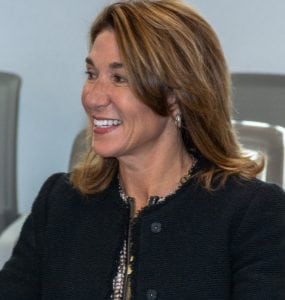
Lt. Governor Karyn Polito (Photo by Lynn F. Boscher)
Polito thanked her EOHED team, naming Deputy Secretary Carolyn Kirk, Bill Ennen, community liaison for the Massachusetts Broadband Institute and Larkin for their “dedication to this project, your willingness to listen, and understanding of the needs of the communities.” She also thanked WG&E, Comcast, and Charter for “stepping up.” Comcast and Charter are also providing last mile connectivity services in the hilltowns.
Polito said that regular summits with the utility companies have been helpful, as well as weekly meetings held locally, which worked through “pole by pole by pole.”
“It was an incredible process,” Polito said, acknowledging the hard work of engaging taxpayers who were thinking it would never get done. “We will get to every single community,” she emphasized, stressing that it is a public safety, public health and economic issue.

MaryEllen Kennedy, Broadband Commissioner from New Salem. (Photo by Lynn F. Boscher)
Representatives of some of the towns working with WG&E then spoke. MaryEllen Kennedy, co-chair of the broadband committee for the town of New Salem, said 85% of that town is owned by Mass Department of Conservation and Recreation. She said they have low population density and high environmental sensitivity, and need to install poles to connect the whole town. “We’ve found working with utilities is a daunting task,” Kennedy said.
“Westfield G&E has been a great partner. We needed them to see us through design and construction – where to put the hub, and the procurement piece,” Kennedy added. “We’re really excited to actually see this happening.”
Bill Hiller, the broadband contact for the town of Otis, which started connecting customers in the spring, began by saying, “The Lt. Governor’s hands-on approach is fantastic.”
“I have a parking space in Otis,” Polito responded.
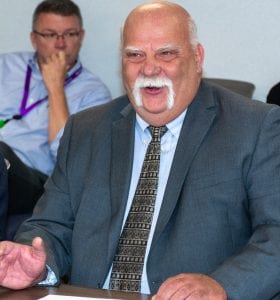
Bill Hiller, Broadband Commissioner from Otis. (Photo by Lynn F. Boscher)
Hiller said they have been developing Otis fiber together, which he called “a work in progress.” He said the town voted overwhelmingly for it, and borrowed $1 million, 20% of their budget, to make it happen. He said they prepaid Verizon and Eversource for the pole work. He stressed that without internet, their town garage was going to lose its license, and their construction company move out of town. He said now, out of 1,600 potential customers, 853 have signed up, and 500 more are committed.
Hiller said Otis also just entered into an agreement with Blandford to help get them up and running. “If we all work together, we can do great things,” he said.
Polito commended all of the volunteers who are driving it locally. “You’re really preparing for the future,” she said to Hiller.
Kimberly Longey of Plainfield said she has been working to connect her town to broadband since 2006. “We’re closer than we’ve ever been. I’m really grateful for the support of WG&E,” Longey said, adding that their skills have augmented her efforts. She said Plainfield overwhelmingly decided to go to a municipal-owned utility.
Longey said that Plainfield has 600 people in 347 households, 42% of whom are over the age of 60, and less than 20% under the age of 30. “Broadband is the key to that solution,” she said, adding, “We’re ready to proceed to construction. Due to sparse population and routes, last mile funding is only getting us 2/3 of the way. The cost is half a million more than we thought. Based on Otis, it will change at least by $50,000.”
Currently, volunteer crews are clearing the land for the hub in Plainfield with chainsaws, Longey said. “The thing that keeps me up at night is not closing the $500,000 gap; it’s affordability of service. We’re trying to keep our end price below $100. If we don’t have a 70% take rate, we don’t have a network,” she added.
Gayle Huntress, co-chair of the Shutesbury broadband committee said she was honored to be there as one of the many representatives who have worked hard to bring broadband to her town. “Over the last five years, the town has had 90 individuals contribute 7,000 hours. It’s like if you announced the Big Dig, and 200,000 people showed up with shovels and stayed for two weeks,” Huntress said, adding, “Your support from the statehouse has been invaluable.”

Governor Charlie Baker and Commissioner Jane Wensley. (Photo by Lynn F. Boscher)
“This issue really got on our radar a year into office,” Gov. Baker responded, thanking them for what he called their “willingness to give us a chance on this one.” Baker said he became aware of a lot of bad blood over previous efforts, and said the work needed geographic credibility. He also said that WG&E has provided professional and geographic credibility “for all kinds of reasons.”
Baker also said the plaintive nature of many of the conversations he had early on caused them to focus on the effort, and drive it. “For all the reasons you’ve said – it’s a must do. There is no more powerful (statement) than how many people have contributed how many hours. The Lt. Governor and I both believe in this,” he said.
“I honestly believe without the enthusiastic, spirited investment Westfield Gas & Electric made, we wouldn’t have been able to pull it off,” Baker added, saying the company brought urgency and forward movement to the effort. “We really appreciate the commitment you and your organization have made. It’s a really terrific story, that’s still being written.”

